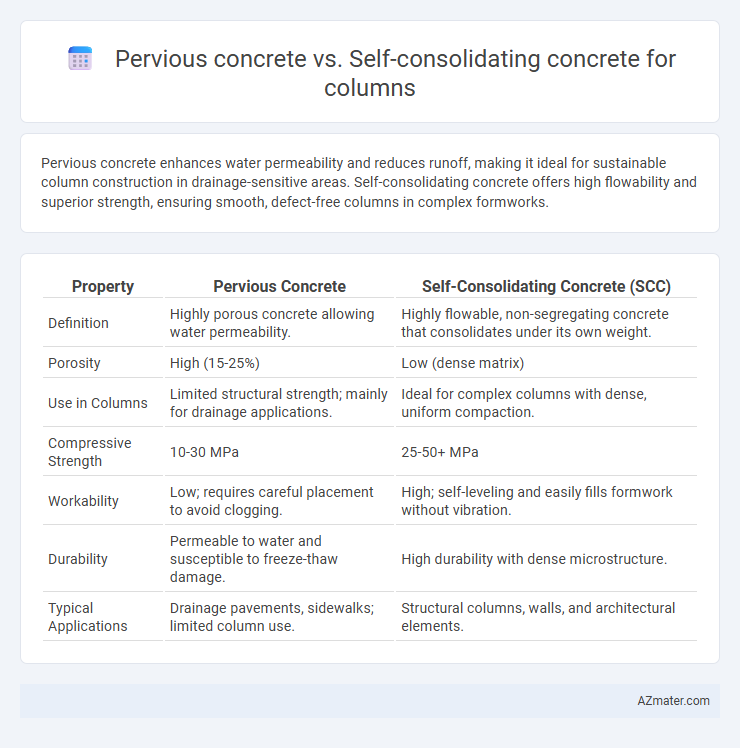Pervious concrete enhances water permeability and reduces runoff, making it ideal for sustainable column construction in drainage-sensitive areas. Self-consolidating concrete offers high flowability and superior strength, ensuring smooth, defect-free columns in complex formworks.
Table of Comparison
| Property | Pervious Concrete | Self-Consolidating Concrete (SCC) |
|---|---|---|
| Definition | Highly porous concrete allowing water permeability. | Highly flowable, non-segregating concrete that consolidates under its own weight. |
| Porosity | High (15-25%) | Low (dense matrix) |
| Use in Columns | Limited structural strength; mainly for drainage applications. | Ideal for complex columns with dense, uniform compaction. |
| Compressive Strength | 10-30 MPa | 25-50+ MPa |
| Workability | Low; requires careful placement to avoid clogging. | High; self-leveling and easily fills formwork without vibration. |
| Durability | Permeable to water and susceptible to freeze-thaw damage. | High durability with dense microstructure. |
| Typical Applications | Drainage pavements, sidewalks; limited column use. | Structural columns, walls, and architectural elements. |
Introduction to Pervious Concrete and Self-Consolidating Concrete
Pervious concrete is a highly porous material designed to allow water infiltration, reducing runoff and improving drainage around columns, making it ideal for sustainable construction practices. Self-consolidating concrete (SCC) is a high-flow, non-segregating concrete that spreads into place and fills formwork without mechanical vibration, enhancing the quality and speed of column construction. Both concrete types offer distinct advantages; pervious concrete improves environmental performance, while SCC ensures superior surface finish and structural integrity in complex column forms.
Key Characteristics of Pervious Concrete
Pervious concrete for columns features high porosity, allowing water permeability that reduces runoff and supports groundwater recharge. Its lower compressive strength compared to self-consolidating concrete limits its use in high-load applications but enhances drainage and environmental benefits in structural design. The distinctive open-graded aggregate structure of pervious concrete contrasts with the dense, highly flowable mix of self-consolidating concrete, which optimizes strength and surface finish for column construction.
Essential Properties of Self-Consolidating Concrete
Self-consolidating concrete (SCC) exhibits superior flowability and viscosity, allowing it to effortlessly fill column forms without segregation or honeycombing, unlike pervious concrete which prioritizes permeability over strength. SCC features high early strength and excellent cohesiveness, ensuring uniform compaction and enhanced structural integrity for columns. Its essential properties--such as resistance to segregation, self-leveling behavior, and stable mixture composition--make SCC optimal for complex column geometries and congested reinforcement zones.
Mix Design Differences for Column Construction
Pervious concrete for columns emphasizes high void content through a low cement paste-to-aggregate ratio and minimal fine aggregates, promoting permeability and drainage. Self-consolidating concrete (SCC) features a highly fluid mix design with superplasticizers and fine aggregates to ensure excellent flowability and self-leveling properties without segregation. The key mix design difference lies in pervious concrete's open-graded aggregate structure versus SCC's dense, cohesive matrix tailored for high-strength, defect-free column construction.
Workability and Placement Techniques in Columns
Pervious concrete offers high permeability but poses challenges in workability and requires careful vibration to prevent voids in column placement, which can affect structural integrity. Self-consolidating concrete exhibits superior flowability and self-leveling properties, enabling effortless placement without mechanical vibration, making it ideal for congested column reinforcement. Optimizing mixture design for both concretes ensures the balance between workability and structural performance in vertical column applications.
Structural Performance: Strength and Durability
Pervious concrete, designed for high permeability, typically exhibits lower compressive strength compared to self-consolidating concrete (SCC), which offers superior structural performance due to its dense matrix and enhanced compaction. SCC provides improved durability by minimizing air voids and reducing permeability, leading to increased resistance against freeze-thaw cycles and chemical attacks in columns. For structural applications demanding high load-bearing capacity and longevity, SCC is preferred, while pervious concrete suits non-structural elements requiring effective water drainage.
Permeability and Water Management Capabilities
Pervious concrete offers high permeability due to its open-graded aggregate structure, enabling effective water drainage and reducing surface runoff in column applications. Self-consolidating concrete, characterized by its dense, flowable mix, provides low permeability, enhancing water resistance and structural durability in columns exposed to moisture. Selecting between pervious and self-consolidating concrete depends on the desired balance between permeability for water management and impermeability for structural integrity in column construction.
Cost Implications for Column Applications
Pervious concrete typically offers lower initial material costs compared to self-consolidating concrete (SCC), but may incur higher maintenance expenses due to its porous nature affecting durability in column applications. SCC, while more expensive upfront owing to its specialized admixtures and higher cement content, reduces labor costs through ease of placement and superior flowability, ensuring faster construction cycles and minimal defect repairs in columns. Long-term cost efficiency favors SCC in structural columns where strength, finish quality, and minimal permeability are critical for durability and reduced lifecycle expenses.
Sustainability and Environmental Impact
Pervious concrete enhances sustainability by significantly improving stormwater management and reducing runoff, which mitigates urban flooding and replenishes groundwater, thereby promoting environmental balance. Self-consolidating concrete offers benefits in reducing construction waste and lowering energy consumption due to its high flowability and ease of placement, which shortens project timelines and decreases labor intensity. Both materials contribute to sustainable construction, with pervious concrete focusing on water conservation and self-consolidating concrete optimizing resource efficiency in column applications.
Choosing the Right Concrete for Your Column Construction
Pervious concrete offers superior drainage and permeability, making it ideal for columns in structures requiring water flow management or environmental sustainability. Self-consolidating concrete provides high flowability and excellent compaction without vibration, ensuring dense, defect-free columns in intricate formwork or high-reinforcement scenarios. Selecting between the two depends on whether permeability or structural integrity and ease of placement are the primary priorities for your column construction project.

Infographic: Pervious concrete vs Self-consolidating concrete for Column
 azmater.com
azmater.com